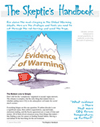|
|
New research shows that the impending climate disaster puts the world in danger of growing too much corn and soy. People won’t know what starving is!
H/t to CO2Science
Qiao et al discovered that when temperatures are raised by a “catastrophic” 2 degrees C, and CO2 is raised to 700 unthinkable ppm corn (aka maize) increases its yield by a remarkable 25%. When hit by both high temperatures and extra CO2, soy bean yield increased even more — by 31%.
Presumably this means crop prices will fall and corn and soy may take over your garden. (So make sure you put in a solar panel to control those new weeds!)
Rumour that nutrient densities will fall — proved to be false. Increased temperature raised the oil content of both crops. And the combo of warmer weather plus CO2 increased most of the nutrients as well. Both crops had more phosphorus, potassium, iron, and zinc. There was a statistically small decrease in calcium in maize, so small it may not be there. The only mineral that definitely declined was manganese in soybeans, and as far as humans go, there is apparently no one on Earth who has a clinical manganese deficiency […]
Hitting the presses today, the vacuous news that lots of companies picked huge numbers out of the air using broken models to guess hyperbolic climate losses coming in the next five years, counter to all the trends for the last hundred years which show declining losses on a GDP basis. The world got warmer but the disasters got less nasty. Less bushfire, less cyclones, less tornadoes, less death per capita. The trends are all good. The only thing that’s up is the number of panic merchants.
World’s biggest firms foresee $1 trillion climate cost hit
LONDON (Reuters) – More than 200 of the world’s largest listed companies forecast that climate change could cost them a combined total of almost $1 trillion, with much of the pain due in the next five years, according to a report published on Tuesday.
So hundreds of companies have offered the climate world a free hit for PR by making a guess. They fall into two kinds of companies –The badgered and harried and the profiteers. See below for examples. Firstly, here’s the only chart that matters.
Global Weather losses are down:
If CO2 causes climate events we need more of it. The […]
Mysterious CO2 activity in New Zealand shows Phytoplankton at work
Tom Quirk both finds a mystery and solves it.
Emiliania huxleyi coccolithophore | Alison Taylor.
Carbon dioxide is a “well mixed gas” yet CO2 levels over New Zealand start rising there each year in March — a whole month before we see it CO2 start to rise over Tasmania. Air over Cape Grim in Tasmania will be blown by the prevailing wind over to New Zealand about five days later. So these two stations should be showing similar numbers throughout the year. Instead some process in NZ is pushing up CO2 early. Levels also peak earlier in New Zealand, and by September, in early spring, some process around NZ is pulling the CO2 out of the sky. Both NZ and Tasmania share large forested areas, so that wouldn’t explain the difference.
Quirk wondered if it had something do with phytoplankton, so he searched for satellite data that measures chlorophyll in the ocean and shows, voila, that there is major activity right around the Baring Head station at the same time as CO2 levels are falling. Indeed, the station is smack in the middle of a mass phytoplankton bloom.
He […]
Back in the unpoliticized Pliocene it’s possible that cosmic rays bombarded Earth and triggered lightning which started fires all around the Earth. This may (warning: speculation) have pushed human ancestors to stand on two legs. In the politicized Holocene, however cosmic rays are “irrelevant”. Ancient cosmic rays can set the Earth on fire apparently, change dominant species, and leave a charcoal layer around the Earth. But changes in cosmic rays lately can *not* cause any changes in modern lightning and cloud cover.
Color me skeptical that there is a cause and effect link between fires and homo-four-legs becoming homo-two-legs. It’s possible, and interesting, but a little bit “just so”. There are many advantages in standing upright — seeing further, reaching higher, standing in water, and carrying booty or babies. Some dinosaurs also evolved to be bipedal.
The study reminds us that for most of human history Space Weather was important. It’s only modern climate models that decree astronomical-stuff = zero.
Another previous study showed that lightning strikes occur in time with the spinning Sun in 150 year old Japanese farm records.
Did ancient supernovae prompt human ancestors to walk upright?
Supernovae bombarded Earth with cosmic energy […]
Remarkable! A new study by Ashcroft, Karoly and Dowdy pieces together an extraordinary 178 years of rainfall data from Sydney, Melbourne and Adelaide. This is a rare study that brings in much older data, looking at trends and extremes. This is pretty much the ultimate long term rainfall paper for South East Australia. Henceforth, there shalt be no more headlines about “unprecedented” rainfall or area’s drying out “due to climate change” unless an event rates against this data…
Australia – a land of floods and droughts: Rainfall goes up and down in long ongoing cycles or change, but no obvious trend that matches the sharp rise of CO2 in the last 30 years. It’s almost like CO2 has no detectable effect… The worst extremes were for the most part — long ago — particularly in the 1840s (assuming those records are reliable). Almost nothing in the last 30 years is unusual or unprecedented despite humans putting out 50% of all our CO2 since 1989. These charts show how misleading it is to use graphs that start in 1970 (or even in 1910) and declare that the recent changes are meaningful, or caused by CO2.
The researchers also use newspaper archives […]
Two different models predict two totally different futures. On the left, catastrophic extinction. On the right, happy bats. Click to enlarge
Yesterday a UN supercommittee of 145 scientists from 50 countries declared that one million species are set for extinction. The same day, ten other scientists published a paper pointing out that most modelers forget to allow for genetic variation and thus overestimate the extinction rate. (It’s like they’re modelling the World of Clones – take one small study, pretend they’re all the same — extrapolate globally.) Have a look at the big difference in model outcomes in figure 1 (right).
As I keep saying, 500 million years of brutal climate change means almost every species carries around an industrial tool-kit of handy genetic tricks. Matz et al estimated corals already have the genes to survived another 250 years of projected IPCC catastrophe (in the unlikely event that it happens). Liew et al showed corals even have epigenetic tricks as well as genetics ones. Another group showed when corals are heated something like 74 different genes are activated — often genes that we don’t even know what they’re there for.
My favourite all time Global Adaptability Prize goes to […]
Next time someone tells you how extreme the climate is today remind them that five million people died in a drought in 1896 in India. That was the same year a brutally hot summer in Australia caused 400 deaths and people fled the inland heat on emergency trains. Somewhere between 1 and 5 million people died a few years later in the next drought — the same time as Australia’s “Federation drought”.
Spot the effect of CO2 in 150 years of rainfall of India:
Average rainfall anomalies in India from 1850 – 2016 from IMD (black) and GISS (red). | Click to read the official caption.
Famine deaths have largely been eliminated in India, mostly thanks to better transport and organisation, higher yields (thanks to fertilizer and CO2) and irrigation. Droughts still happen but in a population that has grown from 250 million in 1880 to a billion in 2000 the extraordinary thing is that more people starved of famine when the population was only a quarter of the size and CO2 levels were “perfecto”.
Weakened people died of cholera and malaria, and bubonic plague too. Death rates to these diseases often doubled or tripled.
Famine, India, 1896.
[…]
Jakobshavn Glacier, Greenland Image: NASA
The Jakobshavn is the glacier that dumps more ice in the ocean than any other in the Northern Hemisphere. It made the iceberg that “sank the titanic”. It has been receding for years, and the losses were accelerating, but then it astonished the scientists.
“At first we didn’t believe it,” said glaciologist Ala Khazendar of NASA’s Jet Propulsion Laboratory. “We had pretty much assumed that Jakobshavn would just keep going on as it had over the last 20 years.”
–ScienceAlert
“That was kind of a surprise. We kind of got used to a runaway system,” said Geological Survey of Denmark and Greenland ice and climate scientist Jason Box. “The good news is that it’s a reminder that it’s not necessarily going that fast. But it is going.”
Box, who wasn’t part of the study, said Jakobshavn is “arguably the most important Greenland glacier because it discharges the most ice in the northern hemisphere. For all of Greenland, it is king.”
— Associated Press
But it’s OK, seriously, we’re all still going to bake in climate hell because all […]
What was Australia’s Environment Minister thinking?
Melissa Price succumbs to pagan witchcraft:
“There’s no doubt that there’s many people who have suffered over this summer. We talk about the Victorian bushfires; (in) my home state of Western Australia we’ve also got fires there,” [Melissa Price] told Sky News this morning. “There’s no doubt that climate change is having an impact on us. There’s no denying that.”
L
WA
Let’s look at her home state. After 67 years of fire management in the giant, hot, dry state of WA, the trend is clear — the more prescribed area we burn, the less wildfire does. In the graph below the prescribed burns declined for forty years and wildfires increased for thirty. After the Dwellingup Fire in 1961 the state ramped up the preventative burns, and reduced wildfires.
As the BushFireFront team say:
“We can’t control the weather but we can control the fuel loads“
Tough call — what do we do, redesign our energy system, pay billions, change our cars, our houses and our light globes in the hope that bush fires will be nicer, or do we just go back to doing […]
Where’s the apocalypse: With all the forecasts of doom, is this it?
Global Lament is rising for the small brown rat (Melomys rubicola) lost off a desert island no one heard of til morning tea today. This is a rat that was only recognised as a distinct species in 1995, though even then, it was debated, and the rat’s existence was hanging by a thread. The island is a 5 hectare sand spit with a bit of low scrub and an old rusty scaffold once called a lighthouse. So it’s all of 0.05 square kilometers: it is so small there is no fresh water on the island, just the odd puddle after it rains. It’s all so ephemeral that over a decade or so the island shrank 40% and the vegetation was wiped out by 97% (details below). Life on shifting sands in the Torres Strait is all pathetically desperate. It’s 200km off Queensland but only 50km from Papua New Guinea and the highest point (if you could call it that) is 3m about the high tide mark. In other words, any decent wave could have washed the last one off. It’s sad, but it’s not “climate change”.
Latch […]
More warming adjustments from ACORN2
Once again we find that the oldest thermometers were apparently reading artificially high even though many were newish in 1910 and placed in approved Stevenson screens.) This is also despite the additional urban warming effect of a population that grew 400% since then. What are the odds?!
Fortunately, gifted craftsmen, sorry scientists have uncovered the true readings from the old biased thermometers which they explain carefully in a 67 page impenetrable document.
Chris Gillham has soldiered through the new “ACORN 2” adjustments that the Australian Bureau of Meteorology has o-so-quietly released and Australians are just waking up to find that our coldest mornings back in 1910 were even colder than anyone realized at the time. Graham Lloyd is reporting in The Australian how the second rewrite in six years increases the warming by 23% . (Where was the ABC announcement?)
The ACORN series of the Bureau of Meteorology includes 112 stations. Their report lists the warming trends per decade in Table 9. I converted that into the total warming since 1910 and graphed that below.
About one third of the warming of our mean temperature is due to man-made adjustments
Comparing AWAP (semi-raw) to the […]
Welcome to the DroneAge, where people act like robots and share dumb ideas at light speed! Episode #601: Climate change makes you lonely and fat.
Feeling friendless, floppy and like a loser? It’s not your fault. Blame a coal plant. Blame Exxon. Blame anyone but yourself. It’s your bad luck to be born into the most bountiful, benevolent era in human history. Damn!
Lonely, unfit and hooked on air-conditioning – is this the summer of the future?
Nicole Hasham, Sydney Morning Herald, uses new unorthodox indicators of “climate change”. Wait for it… test cricket attendance? It’s a smorgasbord of nonsense:
In Perth, cricket fans avoided an historic Test fixture amid predictions of 38-degree days. Sun melted a coastal highway filled with holidaymakers in northern NSW. Victoria’s coal generators shut down. Tasmania burned. And rotting fish corpses lining the Darling River at Menindee forced anglers to seriously rethink their plans.
Are we kidding? Thirty-eight degrees is just a summer’s day in Perth. It’s something that happens 19 years out of 20. As for coal generators shutting down: we’ve spent 20 years trying to drive them out of business to stop climate change, and now, if they don’t work, that […]
After epic flooding in Townsville, witchdoctors are blaming climate change.
Queensland’s recent extreme weather – bushfires, heatwaves, coral bleaching, drought, Cyclone Penny, Townsville’s floods – showed Queensland is clearly experiencing climate change, Professor Ian Lowe said.
Thus spake the Druid of Runes waving a bunch of multifactor complex processes that have been happening forever, can’t be predicted and only have scary trends if you draw short graphs with no error bars. Verily we see doom, doth payth my grant, or whatever it is that keeps Prof Ian Lowe going. He is allegedly in the Queensland Climate Advisory Council (QCAC) — an organization so successful its only existence on the internet appears to be a sidebar on page 15 of a government PDF. But whoever they are, they’re experts, trust us, that the media doesn’t need to ask for an alternate opinion.
Wouldn’t you know it though, floods seem to happen quite a lot in Townsville
This is not to say that the current floods are not serious but just that Townsville is a floody kind of place. It’d be climate change if things stopped flooding in Townsville.
In the last ten days Townsville has had 600mm […]
Image Erin Silversmith
Three amazing things in this story. One that solar cycles might influence the oceans to such an extent that jellyfish plagues are cycling in tune with the sun. Second is that the sun might control food for jellyfish on Earth somehow but have no effect on clouds, temperature or our climate (join the dots that expert climate models don’t). Third is that (briefly) there was actual scientific debate published on the ABC (even if only a few Australians were exposed to it). No one called anyone names, and both sides got to speak (albeit on different channels). Put it in your diary.
A couple of weeks ago on the ABC jellyfish were booming and it was because of climate change:
Jellyfish are causing mayhem as pollution, climate change see numbers boom
RN By Hong Jiang and Sasha Fegan for Late Night Live
…the brainless, spineless, eyeless, bloodless creatures are booming in numbers — and causing mayhem around the world.
Some scientists think jellyfish numbers are increasing as the climate changes — the creatures reproduce well in warmer waters.
Last year, Nick Kilvert of the ABC saw it as a […]
Don’t believe your lying eyes — Australian newspaper archives are full of temperatures recorded higher than 121 in the shade which is 50C. All of these temperatures in the map below are found in historic newspaper archives. Measurements done after 1910 are even done with official Stevenson screens, yet the BOM “throws them away”. It’s true that ones done in the 1800s are often recorded on non-standard equipment, or are just literally “in the shade” under cover. So some of these, perhaps many, are one or two degrees too high. But even if we take two degrees off, how scary is global warming when Australia knew many days of 48C and 49C and some at 50C 120 years ago? The BOM — supposedly so concerned about the State of Our Climate — show little interest in talking about our history or in analyzing it, or even mentioning it.
And modern temperatures are recorded on electronic equipment, sometimes in areas affected by urban heat islands (concrete and cars).
(click to enlarge)
…
50C temperatures have occurred all over Australia before
Australians have been recording temperatures of over 50C since 1828, right across the country. In 1896 the […]
This should end all the Pacific Island climate claims right here. A new study of over 700 islands for decades shows that even though seas are rising faster than any time in the last million years, somehow no islands with people on are shrinking. This means there are no climate change refugees from any vanishing island. Plus it’s more proof that highly adjusted satellite data is recording sea levels on some other planet.
Over the past decades, atoll islands exhibited no widespread sign of physical destabilization in the face of sea-level rise. A reanalysis of available data, which cover 30 Pacific and Indian Ocean atolls including 709 islands, reveals that no atoll lost land area and that 88.6% of islands were either stable or increased in area, while only 11.4% contracted.
Look how closely these researchers are tracking the shores. Below on Tuamoto, French Polynesia, scientists can tell you that islets 12 and 14 (see pic) have disappeared since 1962. So we can track roving blobs of sand about 20 to 30 meters across.
….
No habitable island, none, got smaller:
The researchers reckon that 10 hectares is about the smallest island you’d want to plonk […]
Verily. Eclipses do weird things to people.
Justin Gillis, writer for The New York Times used the recent eclipse to sell something I’d call Sciencemagic. Essentially, if some Scientists™ can calculate orbital mechanics to a fine art, it follows, ipso nonfacto, that all people who use the same job title are also always right.
“Should You Trust Climate Science? Maybe the Eclipse Is a Clue”
Thanks to the work of scientists, people will know exactly what time to expect the eclipse. In less entertaining but more important ways, we respond to scientific predictions all the time, even though we have no independent capacity to verify the calculations. We tend to trust scientists.
If Scientists™ say that solar panels will stop malaria, then buy some! Save lives in Ghana. (What are you waiting for?)
The implications stretch far. Clearly, we can chuck out the whole research thing (labs, who needs em?) Why test predictions, if Scientists™ are 100% accurate? We’ve been wasting money. We don’t need more large hadron colliders, we just need to survey more particle physicists.
This idea that job titles have a kind of truth-telling power is not much different to astrology where truth […]
UPDATE: Libby Plummer at The Daily Mail has a different take, calling this a natural thermostat that cools the upper atmosphere after solar storms. I guess we’ll have to wait to see the paper to see if this can be connected to the global surface temperature at all.
The solar wind is is coming at us at a million miles an hour, but we really don’t know much about what happens when it weaves and buffets past us. In a news release NASA GISS describe how their traditional understanding of what is going on 150 miles up can sometimes just turn inside out. That’s “Revolutions in Understanding the Ionosphere, Earth’s Interface to Space”. It describes how energy from space weather can get into the ionosphere, and also muck up some of our satellites.
Despite climate models being sure that the Sun has hardly any effect, even NASA Giss admits there are some pretty wild things going on up there, and they are mostly due to the Sun. As the solar wind blasts in, it can set up a voltage difference between the upper layers of the atmosphere and the “magnetosphere”. A current will flow, discharging this energy into […]
Peter Boyer seems to think Myron Ebell owes him an apology, but it’s the other way around. And Boyer ought say sorry to his readers.
“Science Communication” is a pretty dismal, immature profession. It’s so bad that an award-winning science communicator can talk about “blunt denial” even while denying basic tenets of logic and appearing to have done almost no research on the global warming debate. If he was ever taught the basics of reasoning, like “correlation is not causation” or “all models are wrong but some are useful,” he’s long forgotten them. What’s an Order of Australia worth these days? Apparently not much.
If he had the open mind he talks about, he might have bothered to read the skeptical sites before he wrote an article. We’d have provided all the evidence an open mind could need to know that Myron Ebell is right on the money. So here Peter, with all due respect, is the red pill — the stuff the UNSW profs of climate crisis won’t tell you even if you dared to ask them.
Talking Point: Keeping an open mind in climate of blunt denial
Peter Boyer
Asked in 2012 what he […]
Yet another paper showing the spooky non-relationship with the local thermonuclear reactor. Thanks to climate models we all know that jiggles in solar radiation mean nothing much to Earth, otherwise we might wonder if the pattern of lows in sunlight and highs in floods meant something…
The River Ammer is in Southern Germany, and Markus Czymzik and others dug through the sediments nearby and graphed the flood layers alongside the small changes in solar radiation (TSI). They noticed that a less active sun correlates with more floods. At the low point of every solar cycle there appears to be more rain. (Don’t buy a house on a floodplain in southern Germany in the next few years.)
There is a pretty neat correlation there in the last 90 years, and then in the second graph they take that correlation back to 3,500BC, back when the Funnelbeaker culture was making nice pots in the same area. This same odd coincidence of the sun and rainfall patterns was also found by researchers in Chile, China and Australian and Indonesia. Low solar activity tends to occur at the same time as the winter jet stream in the North Atlantic gets blocked. And solar activity […]
|
JoNova A science presenter, writer, speaker & former TV host; author of The Skeptic's Handbook (over 200,000 copies distributed & available in 15 languages).

Jo appreciates your support to help her keep doing what she does. This blog is funded by donations. Thanks!


 Follow Jo's Tweets
Follow Jo's Tweets To report "lost" comments or defamatory and offensive remarks, email the moderators at: support.jonova AT proton.me
Statistics
The nerds have the numbers on precious metals investments on the ASX
|












Recent Comments